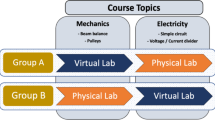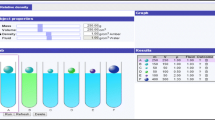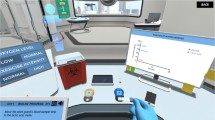Abstract
This study investigated the learning dimensions that occur in physical and virtual inquiry-based lab investigations, in first-year secondary chemistry classes. This study took place over a 2 year period and utilized an experimental crossover design which consisted of two separate trials of laboratory investigation. Assessment data and attitudinal data were gathered and analyzed to measure the instructional value of physical and virtual lab experiences in terms of student performance and attitudes. Test statistics were conducted for differences of means for assessment data. Student attitudes towards virtual experiences in comparison to physical lab experiences were measured using a newly created Virtual and Physical Experimentation Questionnaire (VPEQ). VPEQ was specifically developed for this study, and included new scales of Usefulness of Lab, and Equipment Usability which measured attitudinal dimensions in virtual and physical lab experiences. A factor analysis was conducted for questionnaire data, and reliability of the scales and internal consistency of items within scales were calculated. The new scales were statistically valid and reliable. The instructional value of physical and virtual lab experiences was comparable in terms of student performance. Students showed preference towards the virtual medium in their lab experiences. Students showed positive attitudes towards physical and virtual experiences, and demonstrated a preference towards inquiry-based experiences, physical or virtual. Students found virtual experiences to have higher equipment usability as well as a higher degree of open-endedness. In regards to student access to inquiry-based lab experiences, virtual and online alternatives were viewed favorably by students.



Similar content being viewed by others
References
Akilli GK (2009) Games and simulations: a new approach in education? In: Ferdig RE (ed) Handbook of research on effective electronic gaming in education (3 volumes), vol 3. Information Science Reference, Hershey, PA, pp 1–1759
Akpan J (2001) Using a computer simulation before dissection to help students’ learn anatomy. In: Price J, Willis DA, Davis N, Willis J (eds) Society for information technology & teacher education international conference 2001. AACE, Norfolk, VA, pp 2467–2472
Akpan J, Strayer J (2010) Which comes first the use of computer simulation of frog dissection or conventional dissection as academic exercise? J Comput Math Sci Teach 29(2):113–138
Aladejana F, Aderibigbe O (2007) Science laboratory environment and academic performance. J Sci Educ Technol 16(6):500–506. doi:10.1007/s10956-007-9072-4
Baltzis K, Koukias K (2009) Using laboratory experiments and circuit simulation it tools in an undergraduate course in analog electronics. J Sci Educ Technol 18(6):546–555. doi:10.1007/s10956-009-9169-z
Barnea N, Dori YJ (1999) High-school chemistry students’ performance and gender differences in a computerized molecular modeling learning environment. J Sci Educ Technol 8(4):257–271. doi:10.1023/a:1009436509753
Baxter G (1995) Using computer simulations to assesss hands-on science learning. J Sci Educ Technol 4(1):21–27. doi:10.1007/bf02211578
Bayraktar S (2002) A meta-analysis of the effectiveness of computer-assisted instruction in science education. J Res Technol Educ 34(2):173–188
Bell RL, Trundle KC (2008) The use of a computer simulation to promote scientific conceptions of moon phases. J Res Sci Teach 45(3):346–372. doi:10.1002/tea.20227
Bhargava P, Antonakakis J, Cunningham C, Zehnder AT (2006) Web-based virtual torsion laboratory. Comput Appl Eng Educ 14(1):1–8. doi:10.1002/cae.20061
Bourque DR, Carlson GR (1987) Hands-on versus computer simulation methods in chemistry. J Chem Educ 64(3):232–234
Burkholder PR, Purser GH, Cole RS (2008) Using molecular dynamics simulation to reinforce student understanding of intermolecular forces. J Chem Educ 85(8): 1071-null. doi:10.1021/ed085p1071
Clariana RB (1989) Computer simulations of laboratory experiences. J Comput Math Sci Teach 8(2):14–19
Clark R (1994) Media will never influence learning. Educ Technol Res Dev 42(2):21–29. doi:10.1007/bf02299088
College Board (2010). http://apcentral.collegeboard.com/apc/public/repository/ap-chemistry-course-description.pdf (volume: May 2009, May 2010)
de Jong T (2006) Computer simulations: technological advances in inquiry learning. Science 312(5773):532–533. doi:10.1126/science.1127750
de Jong T, van Joolingen WR (1998) Scientific discovery learning with a computer simulations of conceptual domains. Rev Educ Res 68(2):179–201
Demmin P, Herron P, Miller G, Mullins J, Zipp A (2010) Guide for the recommended laboratory program, pp 29–39
Demonstration of Restructuring in Public Education (2000). California Code—Division 4: Instruction and services [4600.-64100.] (vol. EDC). State of California, USA
Derting TL, Cox JR (2008) Using a tablet PC to enhance student engagement and learning in an introductory organic chemistry course. J Chem Educ 85(12), 1638-null. doi:10.1021/ed085p1638
Dewey J (1938) Logic, the theory of inquiry. H. Holt and Company, New York
Dissection Alternatives Act (2000) 105 ILCS 112 (vol. 105). ILL COMP STAT, Illinois
Donovan W, Nakhleh M (2007) Student use of web-based tutorial materials and understanding of chemistry concepts. J Comput Math Sci Teach 26(4):291–327
Dori YJ, Barak M (2001) Virtual and physical molecular modeling: fostering model perception and spatial understanding. J Educ Technol Soc 4(1):61–74
Dori YJ, Barnea N (1997) In-service chemistry teachers’ training: the impact of introducing computer technology on teachers’ attitudes and classroom implementation. Int J Sci Educ 19(5):577–592
Eylon BS, Linn MC (1988) Learning and instruction: an examination of four research perspectives in science education. Rev Educ Res 58:251–301
Finkelstein ND, Adams WK, Keller CJ, Kohl PB, Perkins KK, Podolefsky NS, et al (2005) When learning about the real world is better done virtually: a study of substituting computer simulations for laboratory equipment. Phy Rev Special Top Phy Educ Res 1(1), 010103-010101–010103-010108
Finkelstein ND, Perkins KK, Adams W, Kohl P, Podolefsky N (2005b) Can computer simulations replace real equipment in undergraduate laboratories? AIP Conf Proc 790(1):101–104
Flick L (1993) The meanings of hands-on science. J Sci Teacher Educ 4(1):1–8. doi:10.1007/bf02628851
Foti S, Ring G (2008) Using a simulation-based learning environment to enhance learning and instruction in a middle school science classroom. J Comput Math Sci Teach 27(1):103–120
Fraser BJ, McRobbie CJ, Giddings GJ (1993a) Development and cross-national validation of a laboratory classroom environment instrument for senior high school science. Sci Educ 77(1):1
Fraser BJ, McRobbie CJ, Giddings GJ (1993b) Development and cross-national validation of a laboratory classroom environment instrument for senior high school science. Sci Educ 77(1):1–24. doi:10.1002/sce.3730770102
Frederiksen JR, White BY, Gutwill J (1999) Dynamic mental models in learning science: the importance of constructing derivational linkages among models. J Res Sci Teach 36(7):808–836
Hsu YS (2008) Learning about seasons in a technologically enhanced environment: the impact of teacher-guided and student-centered instructional approaches on the process of students’ conceptual change. Sci Educ 92(2):320–344. doi:10.1002/sce.20242
Huppert J, Lomask SM, Lazarowitz R (2002) Computer simulations in the high school: students’ cognitive stages, science process skills and academic achievement in microbiology. Int J Sci Educ 24(8):803–821
Jaakkola T, Nurmi S (2008) Fostering elementary school students’ understanding of simple electricity by combining simulation and laboratory activities. J Comput Assist Learn 24(4):271–283. doi:10.1111/j.1365-2729.2007.00259.x
Jaakkola T, Nurmi S, Veermans K (2010) A comparison of students’ conceptual understanding of electric circuits in simulation only and simulation-laboratory contexts. J Res Sci Teach n/a-n/a. doi:10.1002/tea.20386
Jensen WB (2003) The origin of stoichiometry problems. J Chem Educ 80(11), 1248-null. doi:10.1021/ed080p1248
Kennepohl D (2001) Using computer simulations to supplement teaching laboratories in chemistry for distance delivery. J Distance Educ 16:58–65
Kenward MG (2005) Crossover design (encyclopedia of statistics in behavioral science). Wiley, NY
Kinzie M, Jean Foss M, Powers S (1993) Use of dissection-related courseware by low-ability high school students: a qualitative inquiry. Educ Tech Res Dev 41(3):87–101. doi:10.1007/bf02297359
Kirschner P, Huisman W (1998) ‘Dry laboratories’ in science education; computer-based practical work. Int J Sci Educ 20(6):665
Klahr D, Nigam M (2004) The equivalence of learning paths in early science instruction. Psychol Sci 15(10):661–667
Klahr D, Triona LM, Williams C (2007) Hands on what? The relative effectiveness of physical versus virtual materials in an engineering design project by middle school children. J Res Sci Teach 44(1):183–203. doi:10.1002/tea.20152
Kumar D, Sherwood R (2007) Effect of a problem based simulation on the conceptual understanding of undergraduate science education students. J Sci Educ Technol 16(3):239–246. doi:10.1007/s10956-007-9049-3
Lagowski JJ (2002) The role of the laboratory in chemical education. Retrieved 9 July 2004 from http://www.utexas.edu/research/chemed/lagowski/jjl_beijing_02.pdf
Late Nite Labs (2008). http://www.latenitelabs.com/. Accessed Aug 2007
Marshall JA, Young ES (2006) Preservice teachers’ theory development in physical and simulated environments. J Res Sci Teach 43(9):907–937. doi:10.1002/tea.20124
Moore JL, Thomas FH (1983) Computer simulation of experiments: a valuable alternative to traditional laboratory work for secondary school science teaching. Sch Sci Rev 64(229):641–655
Nakhleh MB (1994) A review of microcomputer-based labs: how have they affected science learning? J Comput Math Sci Teach 13(4):368–381
Newby M, Fisher D (1997) An instrument for assessing the learning environment of a computer laboratory. J Educ Comput Res 16(2):179
NSTA (2007) NSTA position statement: the use of computers in science education
Pyatt KA (2009) Case for simulations. In: I Gibson, R Weber, K McFerrin, R Carlsen, DA Willis (eds) Proceedings of society for information technology & teacher education international conference (SITE), Charleston, South Carolina, USA, (pp 1541–1544). AACE, Chesapeake, VA. doi:http://www.editlib.org/p/30832
Pyatt K, Sims R (2007). Learner performance and attitudes in traditional versus simulated laboratory experiences. In: Atkinson RJ, McBeath C, Soong SKA, Cheers C (eds) ICT: providing choices for learners and learning. Proceedings of ASCILITE Singapore 2007, Singapore, 2007 (pp 870–879). Nanyang Technological University, Nanyang Avenue, Singapore 639798: The Center for Educational Development. doi:http://www.ascilite.org.au/conferences/singapore07/procs/
RC N (2006) America’s lab report: investigations in high school science. National Academy Press, Washington, DC
Rivers RH, Vockell E (1987) Computer simulations to stimulate scientific problem solving. J Res Sci Teach 24(5):403–415. doi:10.1002/tea.3660240504
Stieff M, Wilensky U (2003) Connected chemistry—incorporating interactive simulations into the chemistry classroom. J Sci Educ Technol 12(3):285–302. doi:10.1023/a:1025085023936
Stone DC (2007) Teaching chromatography using virtual laboratory exercises. J Chem Educ 84(9), 1488-null. doi:10.1021/ed084p1488
Tao PK, Gunstone RF (1999) The process of conceptual change in force and motion during computer-supported physics instruction. J Res Sci Teach 36(7):859–882. doi:10.1002/(sici)1098-2736(199909)36:7<859:aid-tea7>3.0.co;2-j
Triona LM, Klahr D (2003) Point and click or grab and heft: comparing the influence of physical and virtual instructional materials on elementary school students’ ability to design experiments. Cogn Instr 21(2):149–173
Watson JF, Evergreen Consulting Associates (2007) A national primer on K-12 online learning. North American Council for Online Learning. www.inacol.org/docs/national_report.pdf
Wieman CE, Adams WK, Perkins KK (2008) Physics: PhET: simulations that enhance learning. Science 322(5902):682–683. doi:10.1126/science.1161948
Williamson VM, Abraham MR (1995) The effects of computer animation on the particulate mental models of college chemistry students. J Res Sci Teach 32(5):521–534. doi:10.1002/tea.3660320508
Winn W, Stahr F, Sarason C, Fruland R, Oppenheimer P, Lee YL (2006) Learning oceanography from a computer simulation compared with direct experience at sea. J Res Sci Teach 43(1):25–42. doi:10.1002/tea.20097
Woodrow JEJ (1994) The development of computer-related attitudes of secondary students. J Educ Comput Res 11(4):307–338
Zacharia Z (2003) Beliefs, attitudes, and intentions of science teachers regarding the educational use of computer simulations and inquiry-based experiments in physics. J Res Sci Teach 40(8):792–823. doi:10.1002/tea.10112
Zacharia Z (2005) The impact of interactive computer simulations on the nature and quality of postgraduate science teachers’ explanations in physics. Int J Sci Educ 27(14):1741–1767
Zacharia Z (2007) Comparing and combining real and virtual experimentation: an effort to enhance students’ conceptual understanding of electric circuits. J Computer Assist Learn 23(2):120–132
Zacharia Z, Olympiou G, Papaevripidou M (2008) Effects of experimenting with physical and virtual manipulatives on students’ conceptual understanding in heat and temperature. J Res Sci Teach 45(9):1021–1035. doi:10.1002/tea.20260
Author information
Authors and Affiliations
Corresponding author
Electronic supplementary material
Below is the link to the electronic supplementary material.
Rights and permissions
About this article
Cite this article
Pyatt, K., Sims, R. Virtual and Physical Experimentation in Inquiry-Based Science Labs: Attitudes, Performance and Access. J Sci Educ Technol 21, 133–147 (2012). https://doi.org/10.1007/s10956-011-9291-6
Published:
Issue Date:
DOI: https://doi.org/10.1007/s10956-011-9291-6




